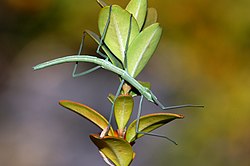| Diapheromeridae | |
|---|---|
 | |
| Spanish walkingstick (Pijnackeria hispanica) (Pachymorphinae: Gratidiini) | |
| Scientific classification | |
| Kingdom: | Animalia |
| Phylum: | Arthropoda |
| Class: | Insecta |
| Order: | Phasmatodea |
| Infraorder: | Anareolatae |
| Family: | Diapheromeridae Kirby, 1904 |
| Diversity | |
| 4 subfamilies (but see text) | |
Diapheromeridae is a family of stick insects (order Phasmatodea) in the suborder Euphasmatodea. [1] As of 2025, the exact position of Diapheromeridae within Euphasmatodea is unknown - it is considered incertae sedis and not assigned to any known superfamily [2] .
Contents
The family contains some huge species, e.g. Paraphanocles keratosqueleton which can grow to over 30 cm long.